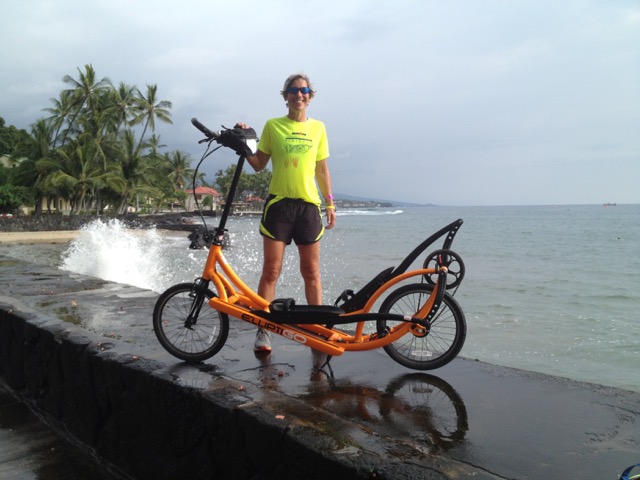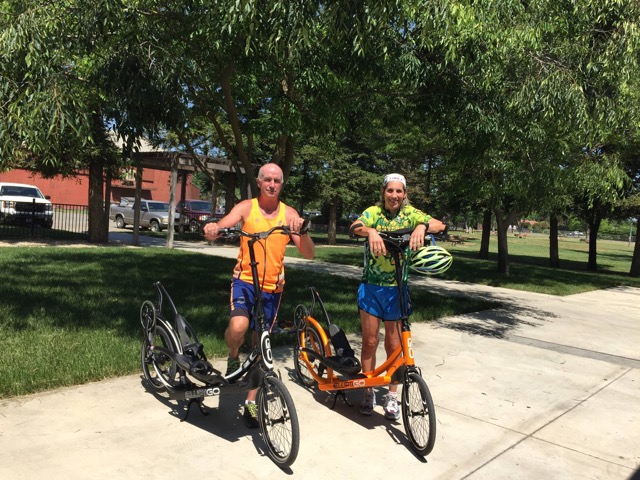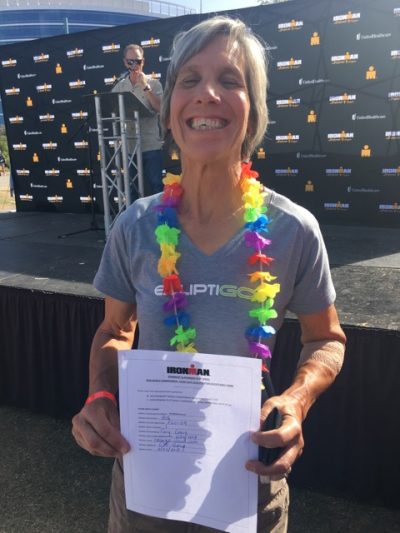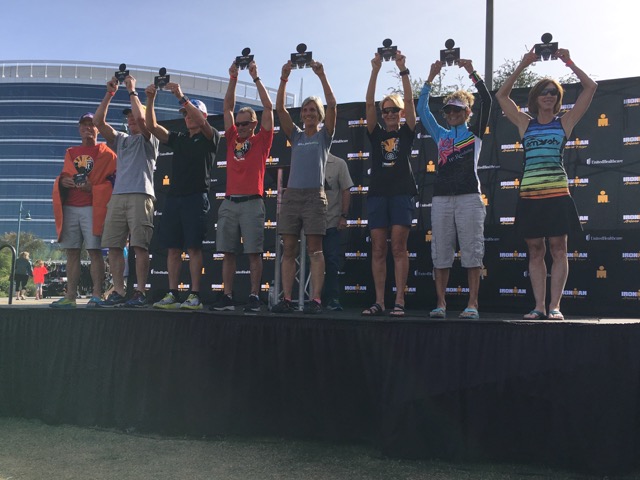Cary Craig was on the ground, bloodied. She had been taken down by a passing cyclist, who clipped her front tire and continued on his way during IRONMAN Arizona (IMAZ) this fall. A highway patrolman was now standing over her, urging her to withdraw.
“Wait a minute! Nooooo!” Cary remembers thinking. “After all the work I’ve done to get this far, this cannot be how it ends! I will not end the season as road kill at Mile 10 of the bike!”
Not to be denied, Carrie chose to rally on. She ended up winning the 60-64 group in 12:22:47 (1:21:10 for the 2.4 mile swim, 5:54:59 for the 112 mile bike and 4:53:05 for the 26.2 mile run), earning herself a coveted spot at the IRONMAN World Championships in Kona for an incredible sixth time.
Cary’s grit and intelligent training have helped her build an impressive athletic resume: in addition to her incredible track record at Kona, she has qualified for the 70.3 World Championship every year since its inception and raced it six times. She has also reached USAT All American status multiple years and earned Ironman All World Athlete status every year since its inception. This past October, Cary placed third at the Elliptical Cycling World Championships.
Cary, who resides in Davis, California, credits her ability to remain competitive to her ElliptiGO 8C and 11R bikes, which she uses for her run training. She took the time to share her journey with ElliptiGO.
Chronic Injuries
I started running when I was 12. Throughout countless marathons and half marathons, including running Boston six times, I always struggled with chronic injuries, with my hips and feet being my weak spots. Osteoarthritis began to develop in my hips at a fairly young age, and I ran for years with chronic plantar fasciitis that was always barely managed. I ran my final marathon at New York City in 2002.
Without running to feed the endurance exercise beast, I sought other ways to feed it. The next logical step was to try triathlon. Like running, I was far more tenacious than fast, so I immediately gravitated to long course triathlon. I qualified for Kona in my first IRONMAN. Racing on the Big Island that first time captivated my body, heart and spirit and I was hopelessly hooked.
More Challenges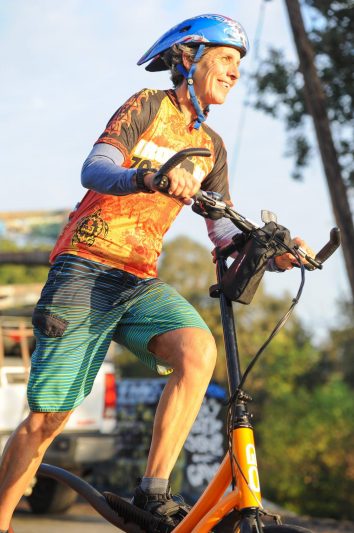
Everything started great in 2013, but then midsummer everything began to fall apart. First, a fall while backpacking resulted in a hip injury. Then, five weeks before Kona, I was hit by a car while riding my bike and sustained a concussion and acetabular labral tears in my other hip. I needed to run, but running wasn’t possible. In a few months, I had gone from being the best athlete I had ever been to being a complete cripple. I was told it was time to change my lifestyle.
I had come back from some major health setbacks before, but this seemed like an actual death sentence on my participation in this sport I loved. I knew from past experience that just biking and swimming would not be a suitable replacement.
Then I met ElliptiGO.
Hello, ElliptiGO
Despite my hip issues, I participated in Kona 2013 hoping for race day magic. No magic – I hobbled through the most painful marathon “run” of my life. During the winter, I tried to do short little jogs a few times a week, until finally one day in January, I pulled up after about a mile into a run and decided I really had to quit all together.
I had always been intrigued by the concept of the ElliptiGO bike. When John Burmester began promoting the bike to our local Davis running community, I decided to take him up on his offer to test ride. One ride and I was immediately smitten! This was the thing that could fill the black hole that was created by giving up running. I became the proud owner of an orange 8C in April of 2014.
With the ability to “run” on the GO, I resumed triathlon training. I participated in the Hawaii 70.3 in June having not actually run a step since that day I pulled up in January. I finished second and earned a spot to 70.3 Worlds in Mt. Tremblant, Quebec. While prepping for this race, I realized that not only was the ElliptiGO bike substituting my run, it was rehabilitating my hips by strengthening key core and hip stabilizing muscles at the same time.
After a year with the ElliptiGO bike, I took the huge step of deciding to try another IRONMAN. At first, my running was always part run/part ElliptiGO bike, but over the course of my prep for IM Wisconsin 2015, I was able to wean myself off of the ElliptiGO bike in my run workouts and it became its own fourth sport. I used the ElliptiGO bike as a supplement to swim/bike/run, and it has remained an integral part of my triathlon training and, I believe, played a huge role in keeping me pain free and relatively healthy.
Even though I can run again, I still love riding my ElliptiGO bike. My running is horribly limited by the biomechanics of my severe hip osteoarthritis. On the ElliptiGO bike, I am liberated from those biomechanical limitations and I can “run” at an intensity that’s not possible when actually running. Additionally, I have discovered that training on the ElliptiGO bike has the added benefit of making me an even stronger cyclist.
ElliptiGO: A Way of Life
Now, a typical training week during my race season consists of 3-4 days a week of swimming with a local masters swim club, two days of run training (one speed/strength day, one long day), two days of bike training (one speed/strength day, one long day) always followed by a 20-30 minute run off the bike, and one “tempo run” day done on my ElliptiGO – a 60-90 minute session at LT effort using a heart rate monitor. I incorporate more ElliptiGO bike sessions during recovery weeks and during the off season.
Since adding the ElliptiGO bike as a training tool, I have discovered new challenges and a whole community of like-minded people, many with stories similar to my own. I’ve been to two Winter Classics, done a number of metric centuries and done the ElliptiGO World Championships/Rally Weekend two times.
I owe a lot to my ElliptiGO bike and am grateful for having my athletic “career” back after thinking it was truly over four years ago.


